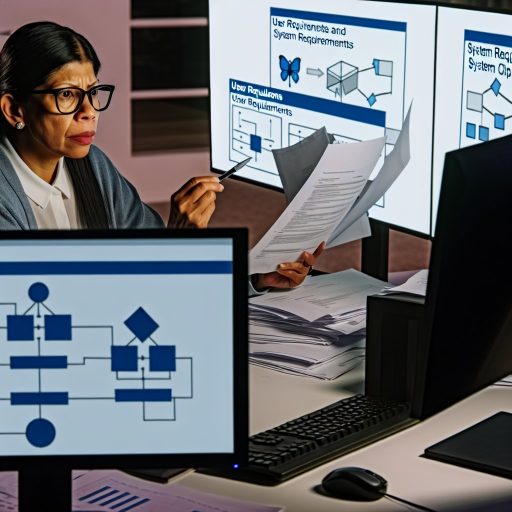Introduction:
Virtualization is the process of creating a virtual version of a device or resource.
Systems administrators rely on virtualization to efficiently manage resources.
This blog post will cover the basics of virtualization and its benefits for admins.
Understanding Virtualization:
Definition and Explanation of Virtualization:
Virtualization is the process of creating a virtual version of something, such as a server, desktop, or application.
Types of Virtualization:
- Server Virtualization: Involves partitioning a physical server into multiple virtual servers.
- Desktop Virtualization: Allows multiple virtual desktops to run on a single physical machine.
- Application Virtualization: Enables applications to run on a virtual environment without being installed on the local system.
Benefits of Virtualization for Systems Administrators:
- Resource Optimization: Virtualization allows for better utilization of hardware resources.
- Cost Efficiency: Reduces the need for physical hardware, saving costs on maintenance and energy.
- Flexibility and Scalability: Makes it easier to scale resources up or down as needed.
- Disaster Recovery: Virtualization facilitates quick disaster recovery through backup and restoration of virtual machines.
- Simplified Management: Centralized management of virtual environments simplifies system administration tasks.
Virtualization Technologies:
Virtualization technologies have revolutionized the way systems administrators manage and operate their infrastructure.
Let’s delve into an overview of popular virtualization technologies, a comparison of their features, capabilities, and costs, as well as considerations for selecting the right virtualization technology for specific needs.
Overview of Popular Virtualization Technologies:
- VMware: VMware is one of the pioneers in virtualization technology, offering a wide range of products for virtualizing servers, desktops, and applications.
- Hyper-V: Developed by Microsoft, Hyper-V is a popular choice for virtualizing Windows environments.
- VirtualBox: VirtualBox, an open-source virtualization platform, is known for its ease of use and support for a variety of operating systems.
Comparison of Features, Capabilities, and Costs:
- VMware: VMware’s products are feature-rich with advanced capabilities like vMotion, High Availability, and Distributed Resource Scheduler.
- Hyper-V: Hyper-V provides a cost-effective solution with features like Dynamic Memory and Storage Migration.
- VirtualBox: VirtualBox is a free virtualization solution with basic features for running virtual machines.
Considerations for Selecting the Right Virtualization Technology:
- Performance Requirements: Consider the performance needs of your workloads and choose a virtualization technology that can meet those requirements without impacting efficiency.
- Scalability: If your organization is planning to scale its infrastructure in the future, opt for a virtualization technology that offers scalability features like live migration and resource pooling.
- Compatibility: Ensure the virtualization technology is compatible with your existing hardware, software, and operating systems to avoid integration challenges and ensure seamless operation.
- Cost: Evaluate the total cost of ownership, including licensing fees, support costs, and hardware requirements, to determine the most cost-effective solution for your organization.
- Security: Prioritize security features like encryption, access controls, and compliance certifications to safeguard your virtualized environments from potential threats and vulnerabilities.
By carefully assessing your requirements and considering these factors, you can select the right virtualization technology that aligns with your organization’s needs and goals.
Whether you choose VMware, Hyper-V, or VirtualBox, each of these technologies offers unique benefits that can enhance the efficiency and flexibility of your IT infrastructure.
See Related Content: Developing Soft Skills as a Virtualization Engineer
Setting Up a Virtualization Environment
When it comes to setting up and configuring a virtualization environment, system administrators need to follow a series of steps to ensure optimal performance and security.
Steps to Set Up a Virtualization Environment:
- Choose a virtualization platform such as VMware, Hyper-V, or VirtualBox.
- Install the virtualization software on the host machine.
- Create virtual machines (VMs) within the virtualization software.
- Allocate resources such as CPU, memory, and storage to each VM.
- Install the operating system and applications on each VM.
- Configure networking settings for communication between VMs and the host machine.
- Test and validate the virtualization environment to ensure it meets the requirements.
Configuration Best Practices for Optimal Performance:
- Regularly monitor and manage resource usage to prevent overloading the host machine.
- Implement backup and disaster recovery strategies for VMs to minimize downtime.
- Use snapshots to capture the state of a VM at a specific point in time for easy restoration.
- Enable hardware virtualization support in the BIOS settings of the host machine.
- Optimize storage configurations by using solid-state drives (SSDs) for better performance.
- Enable memory ballooning to efficiently manage memory allocation among VMs.
Security Considerations When Setting Up Virtual Machines:
- Apply security patches and updates to the host machine and VMs to protect against vulnerabilities.
- Implement network segmentation to isolate sensitive VMs from the rest of the network.
- Use encryption to secure data at rest and in transit between VMs.
- Disable unnecessary services and ports on VMs to reduce the attack surface.
- Regularly audit and review access controls to prevent unauthorized access to VMs.
- Implement intrusion detection and prevention systems to monitor and protect VMs from threats.
By following these steps, configuration best practices, and security considerations, system administrators can effectively set up and manage a virtualization environment that is secure, scalable, and high-performing.
You Might Also Like: IT Security Manager vs. CISO: Key Differences
Virtual Machine Management:
Virtual machines are a crucial aspect of virtualization for systems administrators.
Managing these virtual machines involves various tasks to ensure optimal performance and reliability.
Creating and deploying virtual machines:
- Choose the right virtualization platform based on your organization’s needs.
- Install the necessary software and configure the virtual machine settings.
- Create virtual machine templates to streamline the deployment process.
- Provision virtual machines with the required resources, such as storage and memory.
Monitoring and managing virtual machine performance:
- Monitor resource utilization to identify potential performance bottlenecks.
- Use performance monitoring tools to track CPU, memory, and disk usage.
- Implement resource allocation policies to optimize virtual machine performance.
- Scale virtual machine resources based on changing workload requirements.
Backup and recovery strategies for virtual machines:
- Implement regular backups of virtual machine data to prevent data loss.
- Use automated backup solutions to simplify the backup process.
- Test backup and recovery procedures to ensure data integrity and reliability.
- Implement disaster recovery plans to minimize downtime in case of data loss.
Effective virtual machine management is essential for ensuring the reliability and performance of virtualized environments.
By following best practices in creating and deploying virtual machines, monitoring and managing their performance, and implementing backup and recovery strategies, systems administrators can maintain a robust virtual infrastructure that meets the needs of their organization.
Find Out More: ERP Consultant Success Stories
Networking in a Virtual Environment
One of the key aspects of virtualization for systems administrators is the networking component.
This component plays a crucial role in ensuring seamless communication between virtual resources.
Understanding Virtual Networks and Networking Protocols
- Virtual networks are software-based networks that allow virtual machines to communicate with each other and with the physical network.
- Networking protocols such as TCP/IP, UDP, and Ethernet are essential for establishing communication channels between virtual machines and external networks.
- Virtual switches and routers emulate physical networking devices, enabling virtual machines to connect and communicate effectively.
Configuring Virtual Networks for Communication Between Virtual Machines
- Systems administrators must configure virtual networks with unique IP addresses to enable proper communication between virtual machines.
- Network segmentation and VLANs can help in organizing virtual machines into separate networks for better performance and security.
- Setting up routing tables and firewall rules within virtual networks can enhance network traffic management and security.
Network Security Considerations for Virtualized Environments
- Securing virtual networks involves implementing encryption, authentication, and access controls to protect data and resources from unauthorized access.
- Virtual firewalls and intrusion detection systems help in monitoring and safeguarding virtual networks against potential threats and vulnerabilities.
- Regular security audits and updates are essential to ensure that virtual networks remain resilient and compliant with industry standards.
Networking in a virtual environment is a critical aspect of virtualization for systems administrators.
Transform Your Career Today
Unlock a personalized career strategy that drives real results. Get tailored advice and a roadmap designed just for you.
Start NowUnderstanding virtual networks, configuring them effectively, and implementing robust security measures are essential for ensuring the smooth operation of virtualized environments.
Learn More: Machine Learning in Healthcare: Engineer’s Role

Integration of virtualization with cloud computing
Virtualization plays a crucial role in the world of cloud computing as it enables the creation of multiple virtual instances of servers, storage, and networking resources within a physical environment.
Benefits of using virtualization in cloud environments
- Scalability: Virtualization allows for the easy scaling up or down of resources based on demand, making it ideal for cloud environments.
- Cost Efficiency: By maximizing resource utilization, virtualization helps reduce hardware costs and energy consumption in the cloud.
- Flexibility: Virtualization provides the flexibility to move workloads across different physical servers, improving workload management in the cloud.
- Disaster Recovery: Virtualization simplifies disaster recovery processes by enabling the quick restoration of virtual instances in case of failures.
- Resource Optimization: Virtualization helps optimize resource allocation by dynamically adjusting to workload demands in the cloud.
Challenges and considerations for systems administrators in hybrid cloud environments
- Security Concerns: Systems administrators must address security risks associated with data and workload migration between virtualized and cloud environments.
- Performance Monitoring: Monitoring the performance of virtualized resources in a hybrid cloud setup is crucial for ensuring optimal system efficiency.
- Compliance and Governance: Maintaining compliance with regulations and governance standards is essential when managing hybrid cloud environments.
- Integration Complexity: Integrating virtualized and cloud-based infrastructure can be complex, requiring careful planning and implementation by systems administrators.
- Vendor Lock-in: Systems administrators should consider potential vendor lock-in when choosing virtualization and cloud computing solutions for hybrid environments.
The integration of virtualization with cloud computing offers numerous benefits and challenges for systems administrators in hybrid cloud environments. Understanding these factors and implementing best practices is essential for effectively managing virtualized resources in the cloud. Systems administrators play a key role in optimizing performance, ensuring security, and enabling seamless integration in hybrid cloud setups.
Virtualization Best Practices:
– Implementing best practices for resource allocation and utilization
– Ensuring scalability and flexibility in virtualized environments
– Managing costs and minimizing downtime through effective virtualization practices
Implementing Best Practices for Resource Allocation and Utilization
It is crucial for systems administrators to carefully allocate and manage resources in virtualized environments.
By monitoring resource usage, admins can ensure that each virtual machine has the appropriate amount of CPU, memory, and storage.
Implementing best practices such as dynamic resource allocation can help optimize performance and minimize wastage.
Regularly reviewing and adjusting resource allocations based on usage patterns is essential for maintaining system efficiency.
Ensuring Scalability and Flexibility in Virtualized Environments
Scalability is key in virtualized environments as the number of virtual machines may need to grow over time.
Systems administrators should plan for future growth by ensuring that the virtualized infrastructure can scale horizontally and vertically.
Using tools that automate the scaling process can help to efficiently manage virtual machine growth.
Flexibility is also important, as the ability to quickly adjust resources based on workload demands is critical for business continuity.
Managing Costs and Minimizing Downtime Through Effective Virtualization Practices
Cost management is a key consideration for systems administrators when implementing virtualization solutions.
By optimizing resource utilization and minimizing waste, organizations can reduce overall infrastructure costs.
Implementing disaster recovery and high availability solutions can help minimize downtime and ensure business continuity.
Regularly auditing and optimizing virtualized environments can help identify cost-saving opportunities and improve overall performance.
Virtualization in Modern IT Environments
This blog post has provided valuable insights for systems administrators on virtualization.
Transform Your Career Today
Unlock a personalized career strategy that drives real results. Get tailored advice and a roadmap designed just for you.
Start NowVirtualization plays a crucial role in modern IT environments by optimizing resources and enhancing flexibility.
As systems administrators, it is essential to continue learning and improving virtualization skills.
By embracing virtualization, administrators can streamline operations, increase efficiency, and adapt to evolving technology trends.
The importance of virtualization cannot be overstated in the fast-paced world of IT.
I encourage all systems administrators to stay updated and master virtualization techniques for success.
Additional Resources
System Administrator – DoD Cyber Exchange
NIST Issues Final Version of Full Virtualization Security Guidelines …




